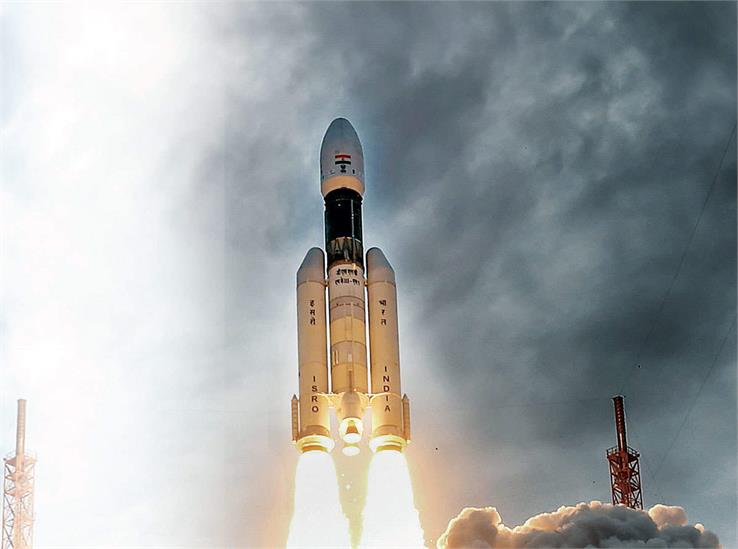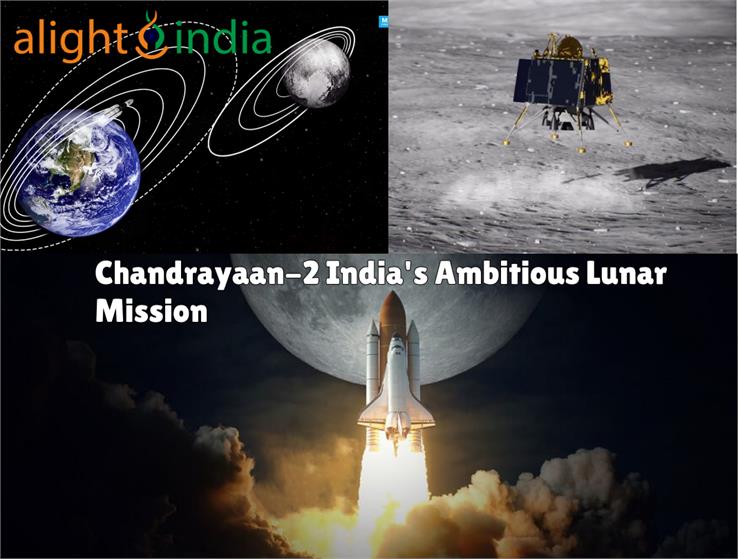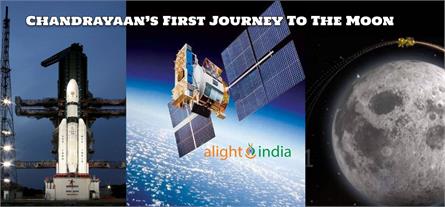Chandrayaan-2: India's Ambitious Lunar Mission
 Space exploration has always captivated humanity's imagination, pushing the boundaries of scientific knowledge and technological prowess. One such endeavor that caught the world's attention was India's Chandrayaan-2 mission – a remarkable demonstration of India's growing capabilities in space exploration. Launched on July 22, 2019, by the Indian Space Research Organisation (ISRO), Chandrayaan-2 was a follow-up to the successful Chandrayaan-1 mission, aiming to further unravel the mysteries of the Moon.
Space exploration has always captivated humanity's imagination, pushing the boundaries of scientific knowledge and technological prowess. One such endeavor that caught the world's attention was India's Chandrayaan-2 mission – a remarkable demonstration of India's growing capabilities in space exploration. Launched on July 22, 2019, by the Indian Space Research Organisation (ISRO), Chandrayaan-2 was a follow-up to the successful Chandrayaan-1 mission, aiming to further unravel the mysteries of the Moon.
Also Read: The History And Culture of India
ISRO's Ambitious Endeavor | Chandrayaan Two's Journey to the Moon | Unlocking Lunar Secrets
The journey of Chandrayaan 2 to the moon is truly an ambitious endeavor by ISRO. The mission is focused on unlocking the secrets of the moon and gathering valuable data that will benefit the scientific community. It is exciting to think about the discoveries that will be made through this mission and how they will contribute to our understanding of the universe.
Aim and Objectives
Chandrayaan-2 was a multifaceted mission designed to explore and understand various aspects of the Moon, from its surface composition to its exosphere, with a special focus on the lunar south pole region.
The mission encompassed three main components: the Orbiter, the Lander (Vikram), and the Rover (Pragyan).
1. Orbiter
The Orbiter is the primary spacecraft that remains in lunar orbit. It was designed to study the Moon from orbit for at least one year. It carries a suite of scientific instruments that includes cameras, spectrometers, and other sensors. These instruments are capable of mapping the lunar surface and studying the Moon's composition, exosphere, and atmosphere. The Orbiter was successfully placed into lunar orbit and continues to send valuable data back to Earth.
2. Vikram (Lander)
Vikram was the lander component of Chandrayaan-2. Its primary mission was to soft-land on the lunar surface near the south pole and deploy the Pragyan rover.
The lander was named after Dr. Vikram Sarabhai, the founder of the Indian Space Program. Vikram was equipped with scientific instruments to study the lunar surface and measure seismic activity on the Moon. Unfortunately, during its descent to the lunar surface on September 6, 2019, Vikram encountered difficulties in the final moments of landing. It lost communication with mission control and was unable to make a successful soft landing. As a result, the lander's fate remained uncertain, and it was declared lost.
3. Pragyan (Rover)
Pragyan, which means "wisdom" in Sanskrit, was the rover designed to explore the lunar surface. It was housed within the Vikram lander. The rover was equipped with scientific instruments, including a spectrometer to analyze the composition of lunar soil and a seismometer to study lunar quakes. Since the Vikram lander was unable to make a successful landing, Pragyan was not deployed, and its mission was ultimately canceled.
While the Vikram lander and Pragyan rover did not achieve their intended mission objectives due to the landing failure, the Chandrayaan-2 Orbiter has continued to provide valuable data and insights about the Moon from orbit. The mission represented a significant achievement for ISRO and demonstrated India's capabilities in lunar exploration.
Also Read: India’s First Moon Mission Chandrayaan-1
Technological Challenges and Achievements
Chandrayaan-2 was not without its challenges, and its journey wasn't entirely smooth. The soft landing attempt of the lander, Vikram, proved to be a tense moment for the ISRO team and the nation. Unfortunately, the lander lost communication with the ground station during its descent, leading to a failed landing. Despite this setback, the orbiter component of the mission was a resounding success.
The orbiter, armed with eight state-of-the-art scientific instruments, continued to orbit the Moon successfully. It played a pivotal role in transmitting valuable data back to Earth, contributing significantly to lunar science. The orbiter's High-Resolution Camera (OHRC) captured stunning images of the lunar surface, providing insights into its geological features and surface composition.
Scientific Discoveries and Contributions
Chandrayaan-Two's scientific findings have expanded our understanding of the Moon's history, composition, and geology. Some of the key discoveries and contributions include:
1. Water Molecules on the Moon
One of the most significant discoveries was the presence of water molecules on the lunar surface. The orbiter's instruments detected water molecules and hydroxyl on the Moon, suggesting the possibility of water ice in permanently shadowed regions near the poles.
2. Mapping Lunar Surface
The high-resolution images captured by the orbiter provided detailed information about the Moon's topography, mineral composition, and distribution of elements. This data is crucial for understanding the Moon's geological evolution and history.
3. Understanding Exosphere
The orbiter's instruments helped study the Moon's exosphere – the extremely thin atmosphere-like layer surrounding it. This research contributes to our knowledge of how celestial bodies interact with their space environment.
Also Read: The Remarkable Journey of Chandrayaan-3
Future Implications and Beyond
Chandrayaan-2 has laid the foundation for future lunar explorations and scientific endeavors. The mission's findings have inspired scientists to investigate further the Moon's potential resources, including water ice, which could play a vital role in future space missions, such as establishing lunar habitats and enabling deeper space exploration.
The challenges faced during the mission's landing attempt have also provided valuable lessons for ISRO and the global space community. Failures in space exploration are often stepping stones to success, as they offer insights into improving technology and procedures.
In conclusion, Chandrayaan-2 stands as a testament to India's growing prowess in space exploration and scientific research. While the mission faced setbacks, its achievements have significantly contributed to our understanding of the Moon and its importance in the broader context of space exploration. As we look to the future, Chandrayaan-Two's legacy will continue to inspire new generations of scientists and engineers to reach for the stars – and beyond. ISRO has expressed its commitment to continuing lunar exploration in the future with Chandrayaan-3 and other missions.







